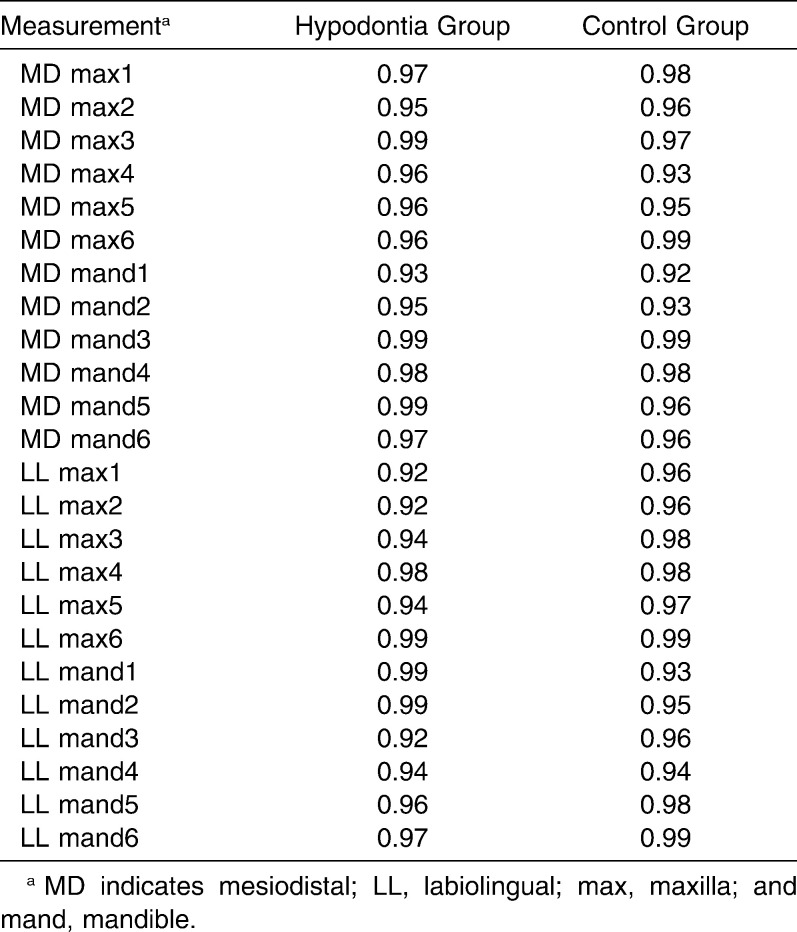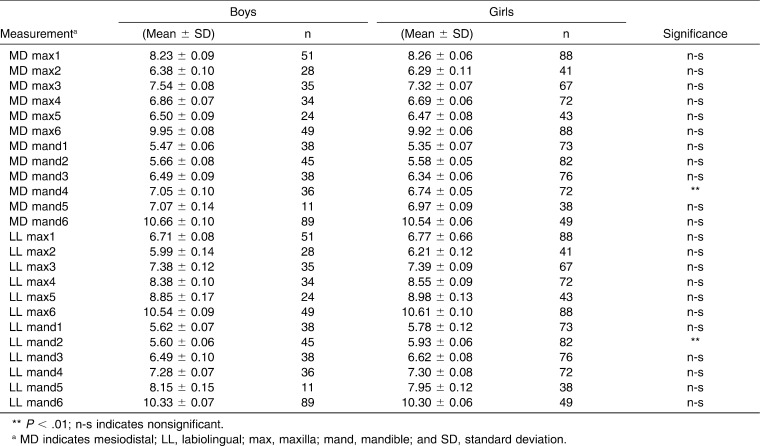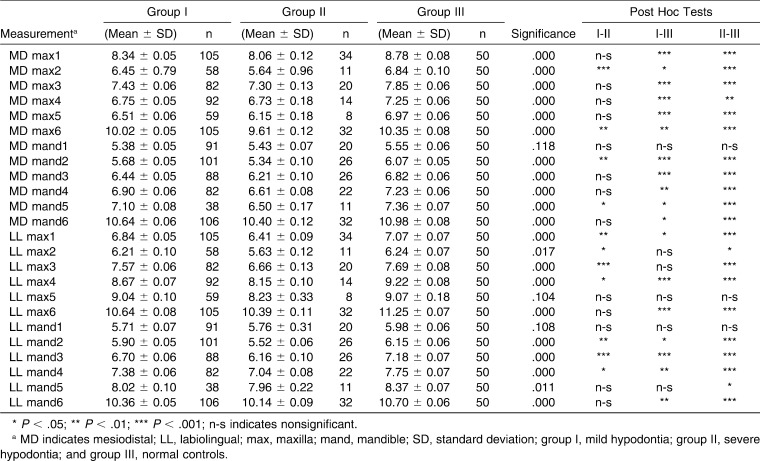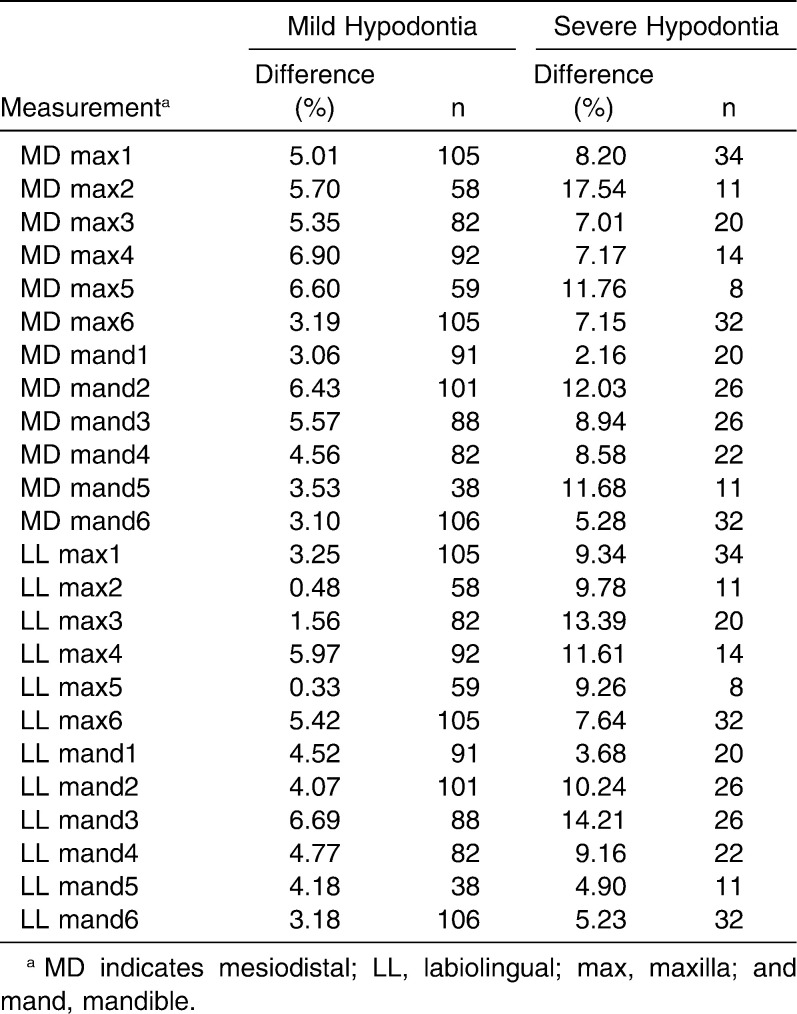Abstract
Objective:
To evaluate and compare the sizes of teeth in mild and severe hypodontia patients with those of healthy controls.
Materials and Methods:
Dental casts of 154 patients with two or more congenitally missing teeth were obtained. Patients were divided into two groups according to severity of hypodontia. Group I (mild) consisted of 118 patients with two to five missing teeth. Group II (severe) consisted of 36 patients with six or more missing teeth. In addition, a control group was included, which consisted of 50 patients who had an Angle Class I jaw relationship and no missing teeth. Mesiodistal and labiolingual dimensions of the teeth were measured with a digital caliper on dental casts. The independent-samples t-test was used to evaluate the effect of gender on measurements. Intergroup differences for mesiodistal and labiolingual dimensions were evaluated with analysis of variance and post hoc Tukey tests.
Results:
Statistically significant differences were found between girls and boys with hypodontia in the mesiodistal dimension of the mandibular first premolar and the labiolingual dimension of the mandibular lateral incisor (P < .01). Mesiodistal and labiolingual width measurements of the teeth of hypodontia patients showed statistically significant differences compared with the control group (P < .05). Most teeth showed significant dimensional reductions in severe hypodontia compared with mild hypodontia (P < .05).
Conclusions:
The mesiodistal and labiolingual dimensions of teeth in both mild and severe hypodontia groups were smaller than those in control subjects. The reduction in size was more excessive in the severe hypodontia group. The teeth showing the greatest difference in tooth dimensions were the maxillary lateral incisor (in mesiodistal dimension) and the mandibular canine (labiolingual dimension).
Keywords: Hypodontia, Oligodontia, Tooth size, Dental cast
INTRODUCTION
Hypodontia, defined as congenital absence of one or more teeth, is a dental disability that affects a patient's function and aesthetics.1,2 It is one of the most common dental anomalies in the permanent dentition.3–5 To describe the phenomenon of congenitally missing teeth, hypodontia is the term most frequently used.6 Another term used to describe a reduced number of teeth is oligodontia. Oligodontia is defined as the condition in which six or more teeth are congenitally missing, excluding the third molars.7
The prevalence of hypodontia varies from 2.63% to 11.2%, depending on race.8–11 Mild hypodontia is relatively common (absence of one to five teeth), but severe hypodontia (oligodontia, the absence of six or more teeth) is rarer. The incidences of hypodontia and oligodontia in a Turkish population were reported as 2.63% and 0.13%, respectively.10 Hypodontia is the most common dental anomaly in the Turkish population.10
The etiology of hypodontia and oligodontia is unclear.12 In the literature, many theories for the etiology of missing teeth have been suggested. It might be the result of either environmental or genetic factors, or a combination of these.13–25
One of the determinants of successful orthodontic treatment with perfect occlusion is harmonious tooth size. Tooth size in relation to the mandibular and maxillary arches determines whether the dentition is spaced or crowded, and discrepancies in the sizes of teeth in different arches determine buccal interdigitation, overjet, overbite, and center line discrepancies.26
Many studies have found that the teeth of patients with congenitally missing teeth have smaller mesiodistal dimensions than normal populations,7,13,26–32 but to our knowledge only a few studies have compared the mesiodistal and labiolingual dimensions of the teeth of hypodontia patients.13,26,30 However, these studies did not take into account the severity of hypodontia.
Therefore, this study sought to evaluate and compare the mesiodistal and labiolingual tooth sizes of mild to severe hypodontia patients with those of healthy controls. The null hypothesis to be tested was that there was no difference between hypodontia groups and the control group in any dimensions of the teeth.
MATERIALS AND METHODS
This prospective study was performed with two hypodontia patient groups (mild and severe) and a control group with all teeth other than the third molars present. All hypodontia patients were white and Turkish and examined in Suleyman Demirel University, Faculty of Dentistry, Department of Orthodontics, between 2005 and 2009 by the same examiner. Hypodontia was diagnosed by radiographic and clinical observations.
The inclusion criterion was the congenital absence of two or more teeth. Persons were excluded if they had any associated syndrome, unexplained previous loss of teeth, caries or restorations on the mesial or distal surfaces of the examined teeth, unerupted or partially erupted teeth, or had undergone previous orthodontic treatment.
Dental casts of 154 patients (98 girls, 56 boys) (mean age, 13.28 ± 3.92 years) with two or more congenitally missing teeth (excluding the third molars) were obtained. The patients were divided into two groups according to the severity of hypodontia. Group I (mild) consisted of 118 patients (78 girls, 40 boys) with two to five missing teeth. Group II (severe) consisted of 36 patients (20 girls, 16 boys) with six or more missing teeth.
Prior to participation in the study, all subjects gave their informed consent after receiving an explanation of the aim of this study. The study protocol was approved by the ethical committee of the University of Suleyman Demirel, Faculty of Medicine.
The control group (group III) included a selection of patients from the University of Suleyman Demirel, Faculty of Dentistry, Department of Orthodontics, who had an Angle Class I jaw relationship with no missing teeth (excluding third molars). Group III consisted of 50 patients (31 girls, 19 boys) with a mean age of 14.26 ± 1.90 years.
The mesiodistal and labiolingual dimensions of the teeth were measured on dental casts with a digital caliper (Guilin Measuring and Cutting Tool Works, Guilin, China) to the nearest 0.01 mm. Measurements were obtained systematically under standardized conditions. The mesiodistal distance was measured as the greatest distance between the contact points on the approximal surfaces of the tooth crown, with the calipers held parallel to the occlusal and buccal surfaces. The labiolingual distance was measured as the greatest distance between the labial and lingual surfaces of the tooth crown in a plane perpendicular to that in which the mesiodistal distance was measured. Teeth were measured on both sides of each dental arch, and the results were averaged.
Three months later, 30 of the 154 dental casts of hypodontia patients and 50 of the control group casts were randomly selected, and measurements were repeated to estimate the repeatability of the measurement technique. Reproducibility coefficients of the all measurements were greater than 0.90 (Table 1). The correlation values did not reveal any systematic measurement error (P > .05).
Table 1. .
Intraclass Correlations of the Measurements
Statistical Methods
All recorded data were statistically analyzed and compared among the groups with SPSS software, version 16.0 (SPSS Inc, Chicago, Ill). The Kolmogorov-Smirnov test was used to see whether the sample was normally distributed. The values indicated that the data were normally distributed (P > .05). Therefore, parametric tests were used. The independent-samples t-test was used to evaluate the effect of gender on measurements. Intergroup differences for mesiodistal and labiolingual dimensions were evaluated using analysis of variance and post hoc Tukey tests. The threshold for significance was set at P < .05.
RESULTS
The mesiodistal and labiolingual width measurements of the teeth according to gender are shown in Table 2. The mesiodistal width of the mandibular first premolar was significantly greater (P < .01) in boys than in girls and the labiolingual width of the mandibular lateral incisor was significantly greater (P < .01) in girls than in boys.
Table 2. .
Mesiodistal and Labiolingual Width Measurements of the Teeth According to Gender
Mesiodistal and labiolingual measurements of the teeth according to severity of hypodontia are shown in Table 3. Both hypodontia groups showed smaller teeth than the control subjects, but the reduction in size was more excessive in the severe hypodontia group. The mesiodistal dimensions of the maxillary lateral incisor (P < .001) and first molar (P < .01) and of the mandibular lateral incisor (P < .01) and second premolar (P < .05) showed significant reductions in severe hypodontia compared with mild hypodontia. The labiolingual dimension of the maxillary first (P < .01) and second (P < .01) incisors, canine (P < .001), and first premolar (P < .05) and that of the mandibular lateral incisor (P < .01), canine (P < .001) and first premolar (P < .05) showed significant reductions in severe hypodontia compared with mild hypodontia.
Table 3. .
Comparison of Mesiodistal and Labiolingual Width Measurements of the Teeth According to Severity of Hypodontia
The percentage reduction in the tooth dimensions of the mild hypodontia patients ranged from 3.06% to 6.90% in the mesiodistal dimension and from 0.33% to 6.69% in the labiolingual dimension (Table 4). The percentage reduction in the tooth dimensions of the severe hypodontia patients ranged from 2.16% to 17.54% in the mesiodistal dimension and from 3.68% to 14.21% in the labiolingual dimension.
Table 4. .
Percentage of Reduction in the Tooth Dimensions of Hypodontia Patients Versus Tooth Dimensions in Normal Patients
The teeth that showed the greatest difference in dimensions were the maxillary first premolar in mild hypodontia and the maxillary lateral incisor in severe hypodontia for the mesiodistal dimension; for labiolingual dimension, the tooth showing the greatest difference in tooth dimensions in both mild and severe hypodontia was the mandibular canine.
DISCUSSION
The aim of this study was to evaluate and compare tooth sizes in mild and severe hypodontia with the tooth sizes in normal subjects. The dimensions of the teeth did not differ according to gender except for the mesiodistal width of the mandibular first premolar and the labiolingual width of the mandibular lateral incisor. Although a statistically significant difference was reported, the mean difference was only 0.3 mm for both teeth, and this is likely not clinically significant, especially considering the dimensional accuracy of the plaster models from which the measurements were taken. Most authors have reported no difference in tooth sizes between girls and boys.7,13,26–32 Brook et al.33 reported that female hypodontia patients showed less difference in the size of their canines relative to normal controls than male hypodontia patients, and male patients generally showed a greater percentage difference in labiolingual dimensions in the anterior dentition and in mesiodistal dimensions in the posterior dentition. They concluded that the reasons for this trend were unclear at present. This difference might be caused by different etiologies (genetic or environmental) of the missing teeth.
Many authors have reported that patients with congenitally missing teeth had smaller teeth than normal populations in the mesiodistal7,13,26–33 and labiolingual13,26,30 dimensions. The results of this study were in accordance with these studies. We found significant reductions in almost all of the teeth of hypodontia patients in the mesiodistal and labiolingual dimensions. Additionally, we observed smaller mesiodistal and labiolingual tooth dimensions in patients with severe hypodontia than in those with mild hypodontia. Schalk-van der Weide et al.7 concluded that oligodontia is not an isolated phenomenon but is related to a complex of other dental anomalies. Diastemas are frequently seen in patients with congenitally missing teeth. According to the present findings, these diastemata are caused not only by the absence of the teeth but also by the reduced size of the teeth that are present. Clinicians should take this finding into account when planning orthodontic treatment.
Larmour et al.20 reported that the different prevalence of hypodontia at different tooth sites may be associated with developmental timing. It is the later developing teeth in each morphological class that are most frequently absent, eg, the lateral incisor, second premolar, and third molar. Similar to this, Schalk-van der Weide et al.13 stated that, in developing teeth, the mesiodistal dimension is determined before the labiolingual dimension, and the final crown morphology is the result of interactions between timing and the rate of cellular proliferation in the developing tooth germ and the time of onset and spread of mineralization. A reduction in cellular mitotic activity resulting in growth retardation leads to more severely affected late-developing teeth or dimensions, resulting in differences in the labiolingual dimension.
In this study, the teeth that showed the greatest difference in the mesiodistal dimension in both hypodontia groups were the maxillary and mandibular lateral incisors and second premolars. In the labiolingual dimension, the maxillary and mandibular canines showed the most difference. In a recent study, Brook et al.33 found the greatest difference in the mandibular central incisors and maxillary lateral incisors in the mesiodistal dimension and the mandibular central incisor in the labiolingual dimension. They suggest that these teeth may be more susceptible to disturbances during development than the other teeth in the dentition. Our findings in the mesiodistal dimension are in agreement with the theory of morphogenetic fields, which proposes that the latest-forming teeth in each part of the dentition are the most variable in morphology.
This study revealed significant differences in the tooth sizes of hypodontia patients compared to those of healthy controls. Therefore, the null hypothesis was rejected.
CONCLUSIONS
The mesiodistal and labiolingual dimensions of teeth in both mild and severe hypodontia groups were smaller than those in controls. The reduction in size was more excessive in the severe hypodontia group.
The teeth that showed the greatest difference in tooth dimensions were the maxillary lateral incisors in the mesiodistal dimension and the mandibular canines in the labiolingual dimension in patients with severe hypodontia.
REFERENCES
- 1.Ben-Bassat Y, Brin I. Skeletal and dental patterns in patients with severe congenital absence of teeth. Am J Orthod Dentofacial Orthop. 2009;135(3):349–356. doi: 10.1016/j.ajodo.2008.09.002. [DOI] [PubMed] [Google Scholar]
- 2.Goodman JR, Jones SP, Hobkirk JA, King PA. Hypodontia: 1. Clinical features and the management of mild to moderate hypodontia. Dent Update. 1994;21(4):381–384. [Google Scholar]
- 3.Book JA. Clinical and genetical studies of hypodontia. I. Premolar aplasia, hyperhidrosis, and canities prematura; a new hereditary syndrome in man. Am J Hum Genet. 1950;2(3):240–263. [PMC free article] [PubMed] [Google Scholar]
- 4.Ben-Bassat Y, Brin I. Skeletodental patterns in patients with multiple congenitally missing teeth. Am J Orthod Dentofacial Orthop. 2003;124(5):521–525. doi: 10.1016/s0889-5406(03)00620-6. [DOI] [PubMed] [Google Scholar]
- 5.Endo T, Ozoe R, Yoshino S, Shimooka S. Hypodontia patterns and variations in craniofacial morphology in Japanese orthodontic patients. Angle Orthod. 2006;76(6):996–1003. doi: 10.2319/082905-303. [DOI] [PubMed] [Google Scholar]
- 6.Arte S. Phenotypic and Genotypic Features of Familial Hypodontia. Institute of Dentistry Department of Pedodontics and Orthodontics;; 2001. University of Helsinki, Helsinki, Finland. [Google Scholar]
- 7.Schalk-van der Weide Y, Steen WH, Bosman F. Distribution of missing teeth and tooth morphology in patients with oligodontia. ASDC J Dent Child. 1992;59(2):133–140. [PubMed] [Google Scholar]
- 8.Sisman Y, Uysal T, Gelgor IE. Hypodontia. Does the prevalence and distribution pattern differ in orthodontic patients. Eur J Dent. 2007;1(3):167–173. [PMC free article] [PubMed] [Google Scholar]
- 9.Polder BJ, Van't Hof MA, Van der Linden FP, Kuijpers-Jagtman AM. A meta-analysis of the prevalence of dental agenesis of permanent teeth. Community Dent Oral Epidemiol. 2004;32(3):217–226. doi: 10.1111/j.1600-0528.2004.00158.x. [DOI] [PubMed] [Google Scholar]
- 10.Altug-Atac AT, Erdem D. Prevalence and distribution of dental anomalies in orthodontic patients. Am J Orthod Dentofacial Orthop. 2007;131(4):510–514. doi: 10.1016/j.ajodo.2005.06.027. [DOI] [PubMed] [Google Scholar]
- 11.Chung CJ, Han JH, Kim KH. The pattern and prevalence of hypodontia in Koreans. Oral Dis. 2008;7:620–625. doi: 10.1111/j.1601-0825.2007.01434.x. [DOI] [PubMed] [Google Scholar]
- 12.Schalk-van der Weide Y, Bosman F. Tooth size in relatives of individuals with oligodontia. Arch Oral Biol. 1996;41(5):469–472. doi: 10.1016/0003-9969(95)00143-3. [DOI] [PubMed] [Google Scholar]
- 13.Schalk-van der Weide Y, Steen WH, Beemer FA, Bosman F. Reductions in size and left-right asymmetry of teeth in human oligodontia. Arch Oral Biol. 1994;39(11):935–939. doi: 10.1016/0003-9969(94)90076-0. [DOI] [PubMed] [Google Scholar]
- 14.Cobourne MT. Familial human hypodontia—is it all in the genes. Br Dent J. 2007;203(4):203–208. doi: 10.1038/bdj.2007.732. [DOI] [PubMed] [Google Scholar]
- 15.Vastardis H, Karimbux N, Guthua SW, Seidman JG, Seidman CE. A human MSX1 homeodomain missense mutation causes selective tooth agenesis. Nat Genet. 1996;13(4):417–421. doi: 10.1038/ng0896-417. [DOI] [PubMed] [Google Scholar]
- 16.van den Boogaard MJ, Dorland M, Beemer FA, van Amstel HK. MSX1 mutation is associated with orofacial clefting and tooth agenesis in humans. Nat Genet. 2000;24(4):342–343. doi: 10.1038/74155. [DOI] [PubMed] [Google Scholar]
- 17.Stockton DW, Das P, Goldenberg M, D'Souza RN, Patel PI. Mutation of PAX9 is associated with oligodontia. Nat Genet. 2000;24(1):18–19. doi: 10.1038/71634. [DOI] [PubMed] [Google Scholar]
- 18.Kapadia H, Mues G, D'Souza R. Genes affecting tooth morphogenesis. Orthod Craniofac Res. 2007;10(4):237–244. doi: 10.1111/j.1601-6343.2007.00407.x. [DOI] [PubMed] [Google Scholar]
- 19.Nieminen P. Genetic basis of tooth agenesis. J Exp Zoolog B Mol Dev Evol. 2009;4:320–342. doi: 10.1002/jez.b.21277. [DOI] [PubMed] [Google Scholar]
- 20.Larmour CJ, Mossey PA, Thind BS, Forgie AH, Stirrups DR. Hypodontia—a retrospective review of prevalence and etiology. Part I. Quintessence Int. 2005;36(4):263–270. [PubMed] [Google Scholar]
- 21.Stimson JM, Sivers JE, Hlava GL. Features of oligodontia in three generations. J Clin Pediatr Dent. 1997;21(3):269–275. [PubMed] [Google Scholar]
- 22.Kjaer I, Kocsis G, Nodal M, Christensen LR. Aetiological aspects of mandibular tooth agenesis—focusing on the role of nerve, oral mucosa, and supporting tissues. Eur J Orthod. 1994;16(5):371–375. doi: 10.1093/ejo/16.5.371. [DOI] [PubMed] [Google Scholar]
- 23.Marec-Berard P, Azzi D, Chaux-Bodard AG, et al. Long-term effects of chemotherapy on dental status in children treated for nephroblastoma. Pediatr Hematol Oncol. 2005;22(7):581–588. doi: 10.1080/08880010500198848. [DOI] [PubMed] [Google Scholar]
- 24.Kaste SC, Hopkins KP, Jenkins JJ., III Abnormal odontogenesis in children treated with radiation and chemotherapy: imaging findings. AJR Am J Roentgenol. 1994;162(6):1407–1411. doi: 10.2214/ajr.162.6.8192008. [DOI] [PubMed] [Google Scholar]
- 25.Kaste SC, Hopkins KP, Jones D, et al. Dental abnormalities in children treated for acute lymphoblastic leukemia. Leukemia. 1997;11(6):792–796. doi: 10.1038/sj.leu.2400670. [DOI] [PubMed] [Google Scholar]
- 26.McKeown HF, Robinson DL, Elcock C, al-Sharood M, Brook AH. Tooth dimensions in hypodontia patients, their unaffected relatives and a control group measured by a new image analysis system. Eur J Orthod. 2002;24(2):131–141. doi: 10.1093/ejo/24.2.131. [DOI] [PubMed] [Google Scholar]
- 27.Garn SM, Lewis AB. The gradient and the pattern of crown-size reduction in simple hypodontia. Angle Orthod. 1970;40(1):51–58. doi: 10.1043/0003-3219(1970)040<0051:TGATPO>2.0.CO;2. [DOI] [PubMed] [Google Scholar]
- 28.Garn SM, Lewis AB. Effect of agenesis on the crown-size profile pattern. J Dent Res. 1969;48(6):1314. doi: 10.1177/00220345690480064401. [DOI] [PubMed] [Google Scholar]
- 29.Rune B, Sarnas KV. Tooth size and tooth formation in children with advanced hypodontia. Angle Orthod. 1974;44(4):316–321. doi: 10.1043/0003-3219(1974)044<0316:TSATFI>2.0.CO;2. [DOI] [PubMed] [Google Scholar]
- 30.Baum BJ, Cohen MM. Agenesis and tooth size in the permanent dentition. Angle Orthod. 1971;41(2):100–102. doi: 10.1043/0003-3219(1971)041<0100:AATSIT>2.0.CO;2. [DOI] [PubMed] [Google Scholar]
- 31.Göyenç Y. Farklı sayıda kongenital diş eksikliğine sahip bireylerin dişsel ve iskeletsel olarak değerlendirilmesi. Türk Ortodonti Dergisi. 1993;6(2):134–140. [Google Scholar]
- 32.Woodworth DA, Sinclair PM, Alexander RG. Bilateral congenital absence of maxillary lateral incisors: a craniofacial and dental cast analysis. Am J Orthod. 1985;87(4):280–293. doi: 10.1016/0002-9416(85)90003-x. [DOI] [PubMed] [Google Scholar]
- 33.Brook AH, Griffin RC, Smith RN, et al. Tooth size patterns in patients with hypodontia and supernumerary teeth. Arch Oral Biol. 2008;54(1):63–70. doi: 10.1016/j.archoralbio.2008.05.016. [DOI] [PubMed] [Google Scholar]






